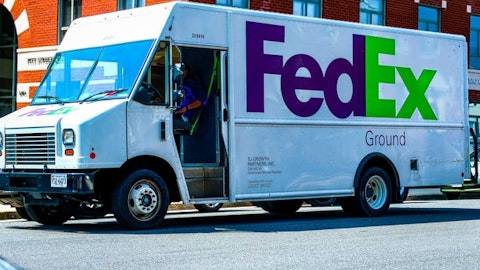Operator: The next question comes from David Vernon with Bernstein.
David Vernon: So Raj, in your prepared remarks, you talked about the Tricolor strategy and going after the premium air freight market. Could you talk a little bit more about what that is? I guess, I’d always been of the assumption that you guys led the premium part of the airfreight market and how does this realignment actually open up some revenue that maybe you don’t have access to today?
Raj Subramaniam: I think I’m going to take a minute here to talk about Tricolor, because I think it’s a good opportunity. So bear with me for the time I’m going to take here. Firstly, Tricolor is a fundamental redesign of our network to improve the utilization of assets, our ROIC, profitability and our operating margin. And first and foremost, our overall capacity will be determined by the demand environment and Tricolor will allow us to better flex our capacity to mass demand. Now within that capacities when we’ll break it into three networks, purple, orange in white, we call it, and that cater to the different cohorts of traffic. The idea is to move the right product and the right network while reducing the cost to serve. The purple network will be a highly optimized and a leaner network designed to move international priority parcel volume that protects our value proposition in different geographies.
Now this network now becomes much more parcel centric, will have significantly better service but also density, and that density will improve the revenue proposition and revenue per flight. Now turning to the orange network, that will cater to the premium freight traffic. And these are FedEx planes that will operate off cycle from the purple system, which allows two things. Firstly, it allows us the ability, once again, to maximize density and asset utilization. It also de-congest hubs and improve service. But most importantly, it allows a truck fly truck model that reduces the cost to serve. And in this context, it should be noted that we are fully leveraging the existing capacity in our trucking networks in the US and Europe. Prior to fiscal ’24, we haven’t really moved any international freight shipments in our market leading LTL network with FXF.
And now it’s already begun to change, but in Tricolor it will take for hold here. So by doing so, we reduced the cost to serve and we are able to target more of the premium air freight segment. Now I’m going to call it a new term, think of it as the global LTL segment, that’s what this is about. Now as you rightly asked, are we adding capacity to go up a low yield and profit, answer is no. We are going to get the overall capacity by the premium demand. It should also be noted that 20% of the global air freight shipments approximately drive about 80% of the weight, which is a primary target for freight forwarders. We’re going to focus on the other 80% that will readily work with the model I described. So the white network then is primarily use of passenger billing capacity to move lower yielding e-commerce and deferred track.
So these three networks working in concert with high technological orchestration is what we call Tricolor. Let me just reinforce again that it helps the baseline productivity, it improves our existing asset utilization and makes the entire system more efficient. And we’re going to manage the execution of Tricolor with the rigor of drive and to ensure success. So again, thanks for the question.
Operator: The next question comes from Brian Ossenbeck with J.P. Morgan.
Brian Ossenbeck: Just wanted to come back and maybe better understand the moving pieces for Express during the quarter. Obviously, quite a strong result but there’s often times some impact from fuel, incentive compensation, I think, there’s a bit of a tailwind here as that changed a little bit as well. So maybe — and then weather, that was a pretty significant surprise considering it was as difficult as you mentioned, Raj, but it seems like it really didn’t affect the network. So maybe, John, if you can unpack some of the moving pieces? And then Raj, if you can comment on the durability of the network if weather is just isn’t going to be as big of an impact going forward?
John Dietrich: I’ll start with that last point, because I think it’s worth repeating on the weather piece, which ties into some of our digital strategies and our ability to adapt, to allow for what was substantially poor weather here in Memphis to be rerouted in a manner that had an immaterial impact on us. So as you’d expect, there was a lot of moving parts at Express, both positive and negative and the levers of DRIVE, the focus on flight reductions. For example, we had 5% fewer flight hours in the quarter. And there are some additional benefits that flow from that on your cost side, because when you’re not flying airplanes, you’re able to avoid certain maintenance costs. The air ops team is doing an exceptional job of managing its cost for aircraft undergrounded, whether you’re using what’s called green time on engines that are available, limiting your inventory purchases and so forth.
So it’s really across the gamut where we’re seeing improvement there, all in the midst of some revenue headwinds that Raj and Brie talked about. So we’re going to continue to keep our head down and focused on our costs. One of the things I’d like to say this is a journey, not a destination and we still have a long way to go at Express, and it is our primary focus and look forward to keeping you posted on further improvements.
Raj Subramaniam: And Brian, I don’t think I have much to add to what John has talked about. I think the idea that we use our latest and greatest in digital tools and the notion that we are now able to look at FedEx as a overarching network and able to move things helps us. Of course, we’ve got to — you’ve got to see as the weather patterns that are very impossible to predict, but I’m just pleased with the work that we did this time around, and we’ll continue to get better in this regard.




